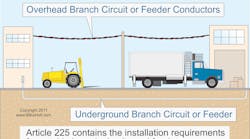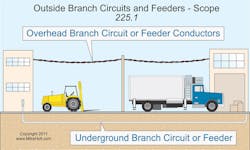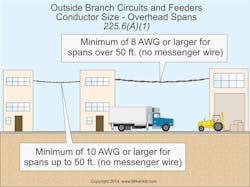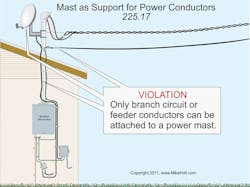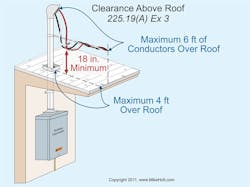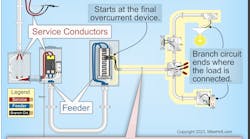Thank you for visiting one of our most popular classic articles. If you’d like to see updated information on this topic, please check out this recently published article, Services and the NEC — Part 1 of 2. |
Outdoor conductors running to buildings aren’t necessarily service conductors. They may be feeders or branch circuit conductors originating in another building. They may provide power for area lighting, outdoor equipment, or a separate structure.
To determine if outdoor conductors are service conductors, identify where the electric utility service point is, and review the Art. 100 definitions for feeders, branch circuits, and service conductors. If they’re service conductors, use Art. 230. Otherwise, use Art. 225, which covers outside feeders and branch circuits (Fig. 1).
Fig. 1. Article 225 contains the installation requirements for outside branch circuits and feeders run on or between buildings, structures, or poles.
Minimum size
You can use conductors 10 AWG or larger for overhead spans up to 50 ft. For spans more than 50 ft, use 8 AWG or larger (unless supported by a messenger wire) [225.6(A)(1)], as shown in Fig. 2.
Fig. 2. For spans over 50 ft, use 8 AWG or larger (unless supported by a messenger wire).
Unless supported by messenger wire, overhead conductors for festoon lighting must be at least 12 AWG. Spans longer than 40 ft must be supported by a messenger wire with strain insulators [225.6(B)].
Support and attachment
Do conductors pass over a roof? If so, use substantial structures to securely support them. If practicable, make the supports independent of the building [225.19, and 230.29]. Don’t use trees or other vegetation to support overhead conductors [225.26].
The point of attachment for overhead conductors must be at least 10 ft above finished grade. Locate it so the whole span maintains the minimum conductor clearance required by 225.18 [225.16(A)].
Attach open conductors to fittings identified for use with conductors, or to noncombustible, nonabsorbent insulators securely attached to the structure [225.16(B) and 230.27]. This point of attachment must meet the minimum clearances specified in 225.18 and 225.19 — and in no case be less than 10 ft above finished grade.
If you use a mast for overhead conductor support, it must have adequate mechanical strength, braces, or guy wires to withstand the strain caused by the conductors. Only feeder or branch circuit conductors can be attached to the feeder and/or branch circuit mast [225.17], as shown in Fig. 3.
Clearances from grade
Overhead conductor spans must maintain these vertical clearances from grade [225.18]:
• 10 ft above finished grade, sidewalks, platforms, or projections from which they might be accessible to pedestrians for 120V, 120/208V, 120/240V, or 240V circuits [225.18(1)].
• 12 ft above residential property and driveways, and those commercial areas not subject to truck traffic for 120V, 120/208V, 120/240V, 240V, 277V, 277/480V, or 480V circuits [225.18(2)].
• 18 ft over public streets, alleys, roads, parking areas subject to truck traffic, driveways on other than residential property, and other areas traversed by vehicles (such as those used for cultivation, grazing, forestry, and orchards) [225.18(4)].
• 24½ ft over track rails of railroads [225.18(5)].
For overhead conductors above pools, outdoor spas, outdoor hot tubs, diving structures, observation stands, towers, or platforms, follow the clearance requirements in 680.8.
Clearances from buildings
Overhead conductors must maintain a vertical clearance of 8 ft above the surface of a roof. Maintain that for a distance of at least 3 ft from the edge of the roof [225.19(A)], except:
• If the roof is subject to pedestrian or vehicular traffic, follow 225.18 [225.19(A) Ex 1].
• When the slope of the roof meets or exceeds 4 in. of vertical rise for every 12 in. of horizontal run, you can reduce the overhead conductor clearances above the roof to 3 ft instead of 8 ft [225.19(A) Ex 2].
• When no more than 6 ft of conductor of 120/208V or 120/240V circuits passes over no more than 4 ft of roof, you can reduce the clearance above only the roof overhang to 18 in [225.19(A) Ex 3], as shown in Fig. 4.
• If the point of attachment is on the side of the building below the roof, the 3 ft clearance from the roof edge doesn’t apply [225.19(A) Ex 4].
Overhead conductors must maintain a clearance of at least 3 ft from:
• Signs, chimneys, radio and television antennas, tanks, and other nonbuilding or nonbridge structures [225.19(B)].
• Windows that open, doors, porches, balconies, ladders, stairs, fire escapes, or similar locations [225.19(D)(1)].
Also, overhead conductors must:
• Maintain a vertical clearance of at least 10 ft above platforms, projections, or surfaces from which they might be reached. Maintain this vertical clearance for 3 ft measured horizontally from the platforms, projections, or surfaces from which they might be reached [225.19(D)(2)].
• Not be installed under an opening through which materials might pass [225.19(D)(3)].
• Not be installed where they will obstruct an entrance to building openings [225.19(D)(3)].
Raceways
Raceways on exterior surfaces of structures must be arranged to drain and be suitable for use in wet locations [225.22]. Underground raceways (used or unused) entering structures must be sealed in accordance with 300.5(G) to prevent moisture from contacting energized live parts [225.27].
Number of supplies
If more than one building or other structure is on the same property, each building/structure must be served by no more than one feeder or single or multiwire branch circuit [225.30]. However, there are five exceptions to this. You can have additional supplies for:
1. Special conditions [225.30(A)]. These are:
• Fire pumps.
• Emergency systems.
• Legally required standby systems.
• Optional standby systems.
• Parallel power production systems.
• Systems designed for connection to multiple sources of supply for the purpose of enhanced reliability.
2. Special occupancies. Multiple-occupancy buildings where there’s no available space for supply equipment accessible to all occupants, or a building/structure so large that two or more supplies are necessary — but only with special permission [225.30(B)].
3. Capacity requirements. Where the capacity requirements exceed 2,000A [225.30(C)].
4. Different characteristics. Different voltages, frequencies, or uses, such as control of outside lighting from multiple locations [225.30(D)].
5. Documented switching procedures. Additional supplies are permitted where documented safe switching procedures are established and maintained for disconnection [225.30(E)].
Disconnects
A disconnecting means is required for all conductors that enter a building or structure [225.31]. Install it at a readily accessible location (either outside or inside) nearest the point of entrance of the conductors [225.32]. There are four exceptions to this rule:
1) If documented safe switching procedures are established, maintained, and monitored by qualified persons, the disconnecting means can be located elsewhere on the premises [225.32 Ex 1].
2) The building or structure qualifies under the provisions of Art. 685 [225.32 Ex 2].
3) For towers or poles used as lighting standards, the disconnecting means is permitted to be located elsewhere on the premises [225.32 Ex 3].
4) For a pole or similar structure used only for the support of signs installed in accordance with Art. 600, the disconnecting means is permitted to be located elsewhere on the premises [225.32 Ex 4].
The building/structure disconnecting means can consist of no more than six switches or six circuit breakers in a single enclosure or separate enclosures for each supply grouped in one location as permitted by 225.30 [225.33].
The building/structure disconnecting means must be grouped in one location, and marked to indicate the loads they serve as required by110.22 [225.34(A)].
To minimize the possibility of accidental interruption of critical power systems, the disconnecting means for a fire pump or for standby power must be located remotely away from the normal power disconnect [225.34(B)].
In a multiple-occupancy building, each occupant must have access to the disconnecting means for their occupancy [225.35]. But if building management provides electrical maintenance under continuous supervision, management can make access available only to building management [225.35 Ex].
The building/structure disconnecting means must be comprised of a circuit breaker, molded case switch, general-use switch, or snap switch “suitable for use as service equipment [225.36].”
If more than one supply feeds a building/structure, a permanent plaque or directory must be installed at each feeder disconnect location denoting all other feeders or branch circuits supplying that structure and the area served by each [225.37].
The disconnecting means can consist of a manual switch or a power-operated switch or circuit breaker capable of being operated manually [225.38(A)]. You can use a shunt-trip pushbutton to open a power-operated circuit breaker. In this case, the breaker (not the pushbutton) is the disconnecting means. The disconnecting means for a building supplied by a feeder must plainly indicate whether it’s in the open or closed position [225.38(D)].
Rating
A single disconnecting means for a building/structure must have an ampere rating at least equal to the calculated load as determined by Art. 220. If the disconnecting means consists of more than one switch or circuit breaker, the combined ratings must be no less than the calculated load as determined per Art. 220 [225.39].
Minimum ratings for disconnecting means:
• For installations consisting of a single branch circuit, the disconnecting means must have a rating of at least 15A [225.39(A)].
• For installations consisting of two 2-wire branch circuits, the feeder disconnecting means must have a rating of at least 30A [225.39(B)].
• For a one-family dwelling, the feeder disconnecting means must have a rating of at least 100A, 3-wire [225.39(C)].
• For all other installations, the feeder or branch circuit disconnecting means must have a rating of at least 60A [225.39(D)].
Three’s a charm
It’s easy to overlook a detail in Art. 225. To avoid that, check your design to ensure you’re meeting these three goals:
1. Maintain clearances. Outdoor conductors present dangers from possible contact that indoor conductors don’t.
2. Support conductors. Outdoor conductors are subject to stresses that indoor conductors aren’t.
3. Follow all rules for the installation of disconnects. This is essential in order to provide a convenient and safe means to disconnect sources of electric power in case of fire or electrocution hazards.
Methodically walk through your design, looking at all of the clearances for conformance to Art. 225. Then repeat with support requirements and disconnect rules.
Holt is the owner of Mike Holt Enterprises, Inc., Leesburg, Fla. He can be reached at www.mikeholt.com.
